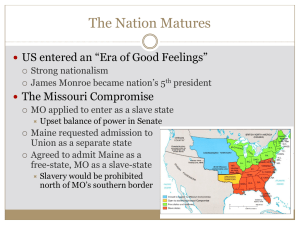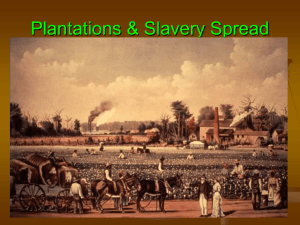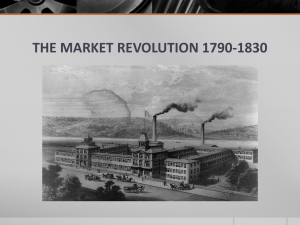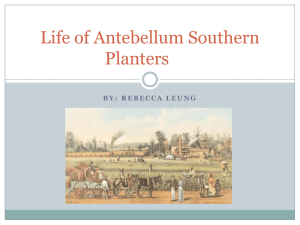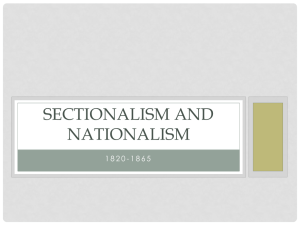Development of improved cotton varieties with medium to long fibre
advertisement
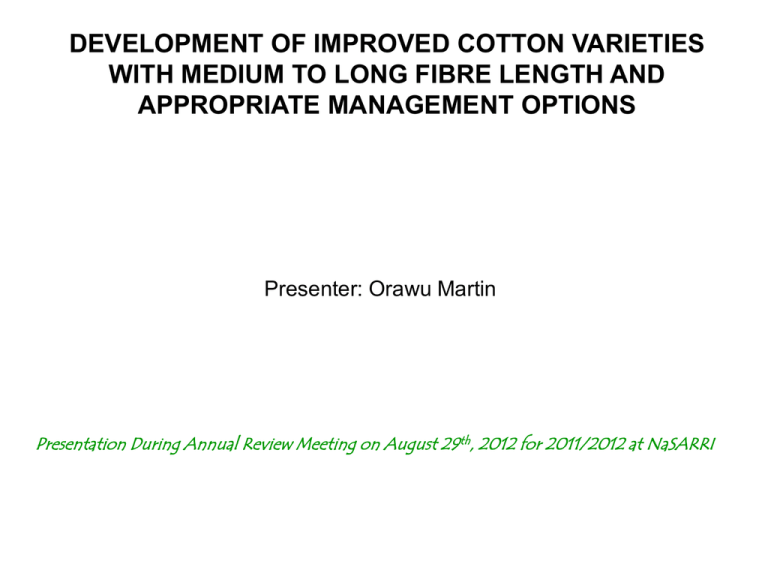
DEVELOPMENT OF IMPROVED COTTON VARIETIES WITH MEDIUM TO LONG FIBRE LENGTH AND APPROPRIATE MANAGEMENT OPTIONS Presenter: Orawu Martin Presentation During Annual Review Meeting on August 29 th, 2012 for 2011/2012 at NaSARRI Cotton Program Staff Scientists: 1. 2. 3. 4. 5. 6. Dr. Epieru George Entomologist Mr. Ogwal Solomon Entomologist Dr. Takan PeterPathologist Mr. Elobu Pius Agronomist Dr. Orawu Martin Plant breeder Ms. Gladys Amonding Plant breeder Technicians: 1. 2. 3. 4. 5. Mr. Aru Charles Mr. Ogwang Robert Mr. Ogwang C.O Mr. Ocan James Mr. Okello Paul Support staff: 1. Mr. Okure Micheal 2. Ms. Alupo Rose 3. Ms. Amito C 4. Ms. Akiteng Jesca Cotton breeding (currently on study leave) Cotton breeding Cotton breeding Cotton agronomy Cotton Pathology Gin fitter Field assistant Field assistant Field/lab. assistant Assets/Infrastructures Office building - 1 and Office space – 7 rooms Laboratory Spaces – 4: (Entomology 2, Breeding 1 and Pathology 1) Field and land utilisation – 35 acres Transport: 1 pick up Problems affecting Cotton Production Low cotton yields Reduction in soil fertility in most farmers’ fields Infestation of major insect pests mainly cotton stainers, lygus bugs, aphids and bollworms Prevalence of cotton diseases mainly Bacterial blight and Fusarium wilts Fig. 1. Cotton Aphids and damage caused to leaves, sucks off plant sap Fig. 3. Young American Bollworm larva boring into a cotton square Fig. 2. Cotton Lygus bugs and damage caused to leaves Fig. 4. Cotton Stainers and damage caused to leaves and bolls Fig. 5. Bacterial blight - vein blight symptoms on leaves Fig. 6. Bacterial blight- angular leaf spot symptoms on leaves Fig. 7. Fusarium wilt on mature cotton plants Specific objectives for period 2011/2012 Develop high yielding cotton varieties with good fibre characteristics Generate appropriate agronomic management options in cotton Generate options that enhances soil fertility in cotton cropping systems Generate integrated pests management options for the control of major insect pests in cotton mainly cotton lygus bugs, bollworms, aphids and stainers Generate integrated disease management options for control of diseases mainly wilts and bacterial blight Project Annual Achievements for Period 2011/2012 120 cotton accessions were assembled on-station and phenotypically characterized 13 elite cotton lines with good agronomic traits were selected for crossing with 10 long staple cotton varieties 130 F1 crosses were generated between 13 elite cotton lines and 10 long staple cotton varieties Six organic foliar fertilizers were tested on cotton. Organic NPK, Megacole and Push increased cotton yields by 19, 12 and 2 % respectively Growing Mucuna puriens for two months on fields to which cotton was later planted, increased available phosphorous by 87% leading to increase of 49 % in seed cotton yields of organic cotton in farmers’ fields in Gulu Site selection for the survey on the distribution and abundance of natural enemies of lygus bugs, bollworms, aphids and cotton stainers were conducted in Gulu, Lira and Pallisa Observations and data collection on spiders, lacewings, lady bird beetles, syrphid flies were carried out on station On station multiplication and evaluation of identified natural enemies of the three important pests were carried out Preliminary observations showed that the three pests share common predators. There is need to determine predator-pest ratio that enables establishment of effectiveness of predators Annual Achievement Cont’d Use of alternative host plants as baits for the management of lygus, bollworms and strainers was carried out Intercrops like maize, sorghum, pigeon pea, sunflower and pearl millet as baits for bollworms, lygus and stainers from cotton was planted Preliminary results showed that bollworms preferred Maize>Pigeon pea>Sorghum>Pearl millet>Sunflower in that order For Lygus the preference is Pearl millet>Sorghum>cotton Efficacy of organic and inorganic pesticides was evaluated: Twiga Lace 100 EC was recommended for popularization on-farm Technical report on efficacy of Engeo was written Cotton germplasm was screened for resistance to Bacterial blight and Fusarium wilts 24 lines showed good resistance to bacterial blight, but most showed low infection to fusarium wilt disease under field conditions Tested five seed dressing chemicals (Three new chemicals - Cruiser Extra, Apron Star and Maxim, and two old chemicals Cuprous oxide and Bronopol) Preliminary results on testing of seed dressing trials at NaSARRI and Ngetta ZARDI showed that Bronopol and Cuprous oxide were the most effective seed dressing chemicals on bacterial blight disease followed by Apron Star, Cruiser Extra and Maxim the least At Pallisa, result showed that Maxim and Cuprous oxide were good at reducing Fusarium wilt incidence followed by Apron Star, Bronopol and Cruiser extra the least Constraints/Problems Lack of proper screen-houses to carry out various activities Most cotton accessions evaluated had short fibre length Growth regulators and defoliants intended for testing on cotton were not available in the market during the season Lack of availability of laboratory reagents/chemicals for molecular studies on races of Fusarium and Verticillium fungi Lack of flow or available funds at time of doing specific activities e.g. prevented testing of organic foliar fertilizers in other areas that have low soil fertility Inability to make fields ready on time led to planting of all on-station cotton trials outside the planting windows Delays in protocols prevented testing of transgenic cotton tolerant to Roundup application and resistant to bollworm damage under confined field trials at NaSARRI and Kasese for the third season Too much rain interfered with management of field activities Inflation raised the cost of labour Irregular power supply interfered with laboratory activities Challenges encountered during project implementation Delayed and insufficient remittance of funding made planting to be carried out late Lack of a functional tractor for on-station field operations delayed implementation of planned activities Lack of fibre testing equipment delayed obtaining data in time. Data usually sent to CDO head office for analysis Erratic power supply to the ginnery delayed ginning of seed cotton before data were generated for analysis Lack of a vehicle to execute program activities during on-farm trials Lack of acquisition of some cotton differentials or genetic markers for identification of races of Fusarium Oxyporium or Verticillium dahliae. • Acquisition of seed dressing chemicals is problem as they are rare in the local market Strategies to overcome challenges in the next implementation period of the project Timely remittance of funds to the institute to enable timely activities to be executed Hire a tractor from outside during field preparation Borrow a vehicle from other programs Send the samples for fibre test analysis to CDO head office Periodic servicing and repair of the available standby generator in case of power fluctuation Need to source some differentials from other research bodies with a similar wilt disease problems Make contacts on seed dressing chemicals with major cotton producing countries Lessons learnt Farmers seem to like varieties with big bolls, irrespective of the yield, and some of them prefer varieties with indeterminate growth Need to carry out more research work to improve on the boll size of BPA 2008 Release of funds is not in line with the planned activities thus making the execution of activities very difficult Research activities in progress Complete conducting the survey, site selection was done Three acres planted for further determination of predator pest ratios for establishing the effectiveness of natural enemies in managing lygus bugs, bollworms and stainers in cotton Five acres planted for further Screening of Engeo for effectiveness in the control of cotton lygus bugs, bollworms and stainers Seven acres planted for further validation of use of IPM options in the control of cotton lygus bugs bollworms and strainer Complete establishing status of wilts on cotton in Uganda Determining races of Fusarium oxysporium and Verticillium dahliae prevalent in Uganda Screening cotton germplasm for resistance to Fusarium and Verticillium wilts, and bacterial blight Screening seed dressing chemicals for control of Fusarium oxysporium and Verticillium dahliae in cotton Collaboration/partnerships Cotton Development Organisation (CDO) on breeding, seed multiplication, testing of seed dressing chemicals, policy advice and training on demonstrations NOGAMU in Uganda on participatory testing of Mucuna puriens to improve soil fertility in Gulu for improved performance of organic cotton Monsanto in USA as source of funds for testing transgenic cotton tolerant to Roundup application and resistant to bollworm damage under confined field trials, and as providers of the technologies Organization of Islamic Conference (OIC) through CDO in the areas of local and International training in all aspects of cotton research and production UGCEA for input supply, training and demonstrations ICAC for international and regional meetings SEACF for regional research planning Syngenta for inputs (insecticides) Balton for Inputs (insecticides) Twiga for Inputs (insecticides) India for Training, infrastructure AGRO ECO – Provides funding and collaborates on long staple cotton research Planned annual outputs for period 2012/13 • Output 1: Phenotypic descriptors of cotton accessions developed by 2013 Key activities: Collecting, characterizing and maintaining of cotton accessions • Output 2: At least 120 cotton accessions collected and genotyped by 2013 Key activity: Genotyping of 120 cotton accessions • Output 3: At least 100 cotton lines with long staple fibre and desired agronomic traits selected from F2 segregating populations Key activity: Hybridizing and selecting F2 segregating populations • Output 4: Appropriate agronomic options for cotton generated Key activities: On-station testing of different growth regulators and cotton defoliants on cotton • Output 5: Options that enhance soil fertility in cotton cropping systems generated Key activities: 1) Testing various foliar fertilizers on cotton at different plant densities on-station and at TVCs 2) Evaluating effectiveness of cover crops to improve soil fertility for cotton 3) On-farm testing of Mucuna puriens to improve soil fertility for organic cotton production Planned annual outputs for period 2012/13 cont’d Output 6: Distribution and abundance of natural enemies of lygus, bollworms, aphids and cotton stainers established • Key activities 1) Surveying on the distribution and abundance of natural enemies of lygus bugs, bollworms, aphids and cotton stainers 2) Field collection and multiplication Output 7: Effectiveness of at least 2 natural enemies evaluated at different agro-ecologies • Key activities: Determining the effectiveness of natural enemies in managing lygus bugs, bollworms, aphids and stainers in cotton Output 8: Effectiveness of at least 2 promising pesticides against major cotton pests evaluated at TVCs and farmers’ fields Key activity: Evaluating synthetic pesticides for their effectiveness in the control of cotton lygus bugs, bollworms, aphids and stainers • Output 9: Four inter-cropping systems evaluated at TVCs • Key activity: Evaluating use of inter-cropping systems in the management of cotton lygus bugs bollworms, aphids and stainers Output 10: Integrated Disease Management (IDM) options for cotton wilts generated • Key activity: Establishing the status of wilts on cotton in Uganda 1) Determining the races of fusarium oxysporium and verticillium dahliae prevalent in Uganda 2) Screening seed dressing chemicals for control of fusarium oxysporium and verticillium dahliae in cotton PARI Publications All quarterly reports for the year were written and submitted to appropriate destinations Demonstrations and leaflets depicting profitability of inter-cropping cotton with legumes and other technologies were exhibited during the National Agricultural Show, World Food Day and Pastoral Week Contributed the section for cotton to the NARO mandate crops: contribution to household income and food security, May 2012 Provided an input to the CDO Cotton Documentary, a video-recorded in May 2012. NaSARRI’s Approach and Innovations to Boost Crop Resistance to Disease and Drought in Uganda: Agricultural Review: Journal of the Agricultural Industry in Africa 17: 16-18 Technical report on evaluation of biological efficacy of Engeo 247 EC (Lamda Cyhalothrin 106g/l + Thiamethoxam 141g/l) was done Revised edition of Farmers’ Cotton Guide Acknowledgments NARO ATAAS CDO GOU - Development and Recurrent budgets Monsanto - USA contributed some funds for CFT facilities and core staff maintenance Other partners


